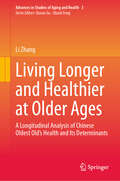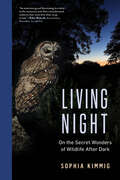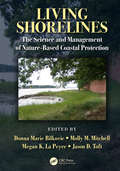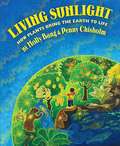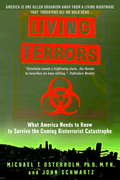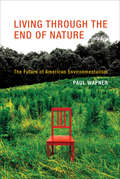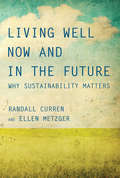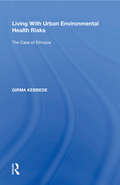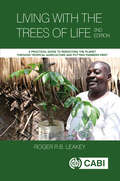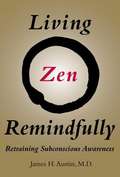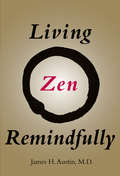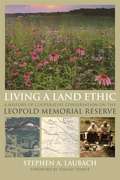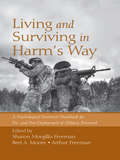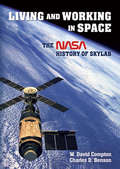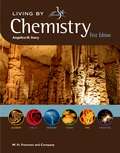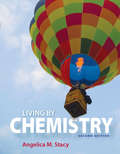- Table View
- List View
Living Fossils (Evolution: The Grand Experiment, Vol. 2)
by Carl WernerIn 1938 the discovery of a large, unusual fish turned the scientific community on end. Dubbed a 'living fossil', the discovery of a coelacanth in a South African river shocked scientists around the world who thought this type of fish had died out millions of years prior during the process of evolution. Whether a shark, leaf, or crab, 'living fossils' are a challenge for evolutionary theorists, and create a fascinating debate among scholars. Do they indicate a younger earth than thought, placing the millions of years timeline in question? Or do they represent a deep mystery? In Living Fossils: Evolution, The Grand Experiment Volume 2 delves into these provocative questions and more. Teaches how science evaluates and classifies the creatures of the world we live in, both past and present. Unveils the surprises that often force a radical re-evaluation of scientific theory and assumption Hundreds of full-color photos. An exceptional follow-up to the popular first title in the series, Living Fossils is a unique and exciting educational resource, perfect for a standalone unit study or integration into your comprehensive education program. Use the series together to provide an in-depth opportunity to explore the origins of man and the world around us, and discover the truth of God's creation like never before.
Living Fossils: Clues To The Past
by Caroline ArnoldYou haven&’t changed a bit! Living fossils, or modern-day animals that very closely resemble their ancient relatives. Meet the coelacanth, horseshoe crab, dragonfly, tuatara, nautilus, and Hula painted frog. All are living fossils. Why have they changed so little over time, while other animals evolved or went extinct? Using contrasting "then" and "now" illustrations, veteran nonfiction writer Caroline Arnold alternates between a prehistoric creature in its native environment and its contemporary living-fossil counterpart. An amazing way to experience the ancient past! Back matter includes a time line, additional information about the six living fossils, a glossary, and suggestions for further reading.
Living In Space (Fountas & Pinnell LLI Gold #Level Q)
by Carmen MoraisLiving in Space Author: Carmen Morais
Living Longer and Healthier at Older Ages: A Longitudinal Analysis of Chinese Oldest Old’s Health and Its Determinants (Advances in Studies of Aging and Health #3)
by Li ZhangThis book analyzes data from eight waves (1998, 2000, 2002, 2005, 2008, 2011-12, 2014 and 2018) of the Chinese Longitudinal Healthy Longevity Surveys (CLHLS) to explore how health status of the Chinese oldest old has changed over time and across birth cohorts. It also intends to investigate how period and birth cohorts have played a role in the associations between Chinese oldest old’s health and a variety of demographic, socioeconomic, and lifestyle factors. The book applies the age-period-cohort (APC) approach and constructs cross-classified random-effects models (CCREMs) to carry out the analyses. The oldest old’s health is measured by self-rated health (SRH), chronic diseases, cognitive function and subjective wellbeing which is indicated by positive and negative feeling scores. The results show that Chinese oldest old’s health status has changed over time and across birth cohorts. Significant period and cohort effects are shown when linking Chinese oldest old’s health to various demographic, socioeconomic and health lifestyle covariates. In general, period effects surpass the cohort effects. Particularly, the oldest old’s subjective wellbeing is more likely to be influenced by period than cohort effects. Period changes caused by social events, such as economic hardship and natural disasters, have left strong imprints on Chinese oldest old’s mental than physical health status. Based on these findings, the book highlights some important policy implications and points out future research directions to improve the current study. It provides an interesting read for researchers in gerontology and public health studies. It is also of interest to general audience, including practitioners in health care and policy makers who are interested in old age care and healthy aging policies.
Living Night: On the Secret Wonders of Wildlife After Dark
by Sophia KimmigNatural darkness isn’t merely a time of day. For countless extraordinary species, it’s home. “An entertaining and illuminating love letter to the mysterious and often misunderstood creatures that come alive when we go to bed—and a call to preserve our precious, shared world.”—Robin Bicknell, award-winning documentary filmmaker, Ice and Fire and Nature’s Cleanup Crew When the sun sets, things start to get interesting among wild animals. Wherever we live, whether in the city or suburbs or country, darkness conjures a hidden world of wildlife that most of us rarely glimpse. Foxes, wolves, and bears prowl while skunks, opossums, and porcupines lurk; fireflies send flashing signals to potential mates; raccoons rummage for food; owls and bats fly overhead. Wildlife biologist Sophia Kimmig is our guide to the startling behaviors of these and many more nocturnal creatures. Introducing us to night’s wild inhabitants, she reveals what life for them is like in this parallel world—how it looks, feels, and smells—and the ingenious ways some creatures thrive after sunset. Living Nighthelps us appreciate how essential darkness is: not just a time but a diverse habitat all to itself—one that we still know too little about, and that we must urgently protect for the benefit of the world’s flora and fauna that depend on the day–night cycle.
Living Shorelines: The Science and Management of Nature-Based Coastal Protection (CRC Marine Science)
by Donna Marie Bilkovic Molly M. Mitchell Megan K. La Peyre Jason D. ToftLiving Shorelines: The Science and Management of Nature-based Coastal Protection compiles, synthesizes and interprets the current state of the knowledge on the science and practice of nature-based shoreline protection. This book will serve as a valuable reference to guide scientists, students, managers, planners, regulators, environmental and engineering consultants, and others engaged in the design and implementation of living shorelines. This volume provides a background and history of living shorelines, understandings on management, policy, and project designs, technical synthesis of the science related to living shorelines including insights from new studies, and the identification of research needs, lessons learned, and perspectives on future guidance. <P><P> <li>Makes recommendations on the correct usage of the term living shorelines <li>Offers guidance for shoreline management in the future <li>Includes lessons learned from the practice of shoreline restoration/conservation <li>Synthesizes regional perspectives to identify strategies for the successful design and implementation of living shorelines <li>Reviews specific design criteria for successful implementation of living shorelines <li>Provides detailed discussions of social, regulatory, scientific and technical considerations to justify and design living shoreline projects <P><P> International perspectives are presented from leading researchers and managers in the East, West and Gulf coasts of the United States, Europe, Canada, and Australia that are working on natural approaches to shoreline management. The broad geographic scope and interdisciplinary nature of contributing authors will help to facilitate dialogue and transfer knowledge among different disciplines and across different regions. This book provides coastal communities with the scientific foundation and practical guidance necessary to implement effective shoreline management that enhances ecosystem services and coastal resilience now and into the future.
Living Sunlight: How Plants Bring the Earth to Life
by Molly Bang Penny ChisholmLIVING SUNLIGHT shows children, teachers, and parents the remarkable magic of what makes us human. This informative yet dramatic book will mesmerize readers and help further a child's understanding of the energy we share with all living things in nature. We are all dancing sunlight. The book is co-authored by award-winning M. I. T. professor Penny Chisholm, a leading expert on ocean science. A perfect addition to any library! Image descriptions present.
Living Systems
by Lawrence Hall of Science University of California at BerkeleyNIMAC-sourced textbook
Living Systems (FOSS Science Resources)
by University of California at Berkeley Lawrence Hall of ScienceLiving Terrors
by John Schwartz Michael T. OsterholmAmerica is one killer organism away from a living nightmare that threatens all we hold dear....A deadly cloud of powdered anthrax spores settles unnoticed over a crowded football stadium.... A school cafeteria lunch is infected with a drug-resistant strain of E. coli.... Thousands in a bustling shopping mall inhale a lethal mist of smallpox, turning each individual into a highly infectious agent of suffering and death....Dr. Michael Osterholm knows all too well the horrifying scenarios he describes. In this eye-opening account, the nation's leading expert on bioterrorism sounds a wake-up call to the terrifying threat of biological attack -- and America's startling lack of preparedness. He demonstrates the havoc these silent killers can wreak, exposes the startling ease with which they can be deployed, and asks probing questions about America's ability to respond to such attacks. Are most doctors and emergency rooms able to diagnose correctly and treat anthrax, smallpox, and other potential tools in the bioterrorist's arsenal? Is the government developing the appropriate vaccines and treatments? The answers are here in riveting detail -- what America has and hasn't done to prevent the coming bioterrorist catastrophe. Impeccably researched, grippingly told, Living Terrors presents the unsettling truth about the magnitude of the threat. And more important, it presents the ultimate insider's prescription for change: what we must do as a nation to secure our freedom, our future, our lives.From the Trade Paperback edition.
Living Things Grow & Change
by Lucy Daniel Jay Hackett Mary Atwater Richard Moyer [et al.]Living Things Grow & Change
Living Through the End of Nature: The Future of American Environmentalism (The\mit Press Ser.)
by Paul WapnerHow environmentalism can reinvent itself in a postnature age: a proposal for navigating between naive naturalism and technological arrogance.Environmentalists have always worked to protect the wildness of nature but now must find a new direction. We have so tamed, colonized, and contaminated the natural world that safeguarding it from humans is no longer an option. Humanity's imprint is now everywhere and all efforts to “preserve” nature require extensive human intervention. At the same time, we are repeatedly told that there is no such thing as nature itself—only our own conceptions of it. One person's endangered species is another's dinner or source of income. In Living Through the End of Nature, Paul Wapner probes the meaning of environmentalism in a postnature age. Wapner argues that we can neither go back to a preindustrial Elysium nor forward to a technological utopia. He proposes a third way that takes seriously the breached boundary between humans and nature and charts a co-evolutionary path in which environmentalists exploit the tension between naturalism and mastery to build a more sustainable, ecologically vibrant, and socially just world.Beautifully written and thoughtfully argued, Living Through the End of Nature provides a powerful vision for environmentalism's future
Living Well Now and in the Future: Why Sustainability Matters (The\mit Press Ser.)
by Randall Curren Ellen MetzgerA philosopher and a scientist propose that sustainability can be understood as living well together without diminishing opportunity to live well in the future.Most people acknowledge the profound importance of sustainability, but few can define it. We are ethically bound to live sustainably for the sake of future generations, but what does that mean? In this book Randall Curren, a philosopher, and Ellen Metzger, a scientist, clarify normative aspects of sustainability. Combining their perspectives, they propose that sustainability can be understood as the art of living well together without diminishing opportunity to live well in the future.Curren and Metzger lay out the nature and value of sustainability, survey the problems, catalog the obstacles, and identify the kind of efforts needed to overcome them. They formulate an ethic of sustainability with lessons for government, organizations, and individuals, and illustrate key ideas with three case studies. Curren and Metzger put intergenerational justice at the heart of sustainability; discuss the need for fair (as opposed to coercive) terms of cooperation to create norms, institutions, and practices conducive to sustainability; formulate a framework for a fundamental ethic of sustainability derived from core components of common morality; and emphasize the importance of sustainability education. The three illustrative case studies focus on the management of energy, water, and food systems, examining the 2010 Gulf of Mexico oil spill, Australia's National Water Management System, and patterns of food production in the Mekong region of Southeast Asia.
Living Well with Menopause: What Your Doctor Doesn't Tell You That You Need to Know
by Carolyn Chambers ClarkNurse and educator describes a thorough holistic approach to menopause. Gives advice on hot flashes, emotional changes, pain, fatigue, weight gain, decreased sex drive, bladder difficulty, insomnia, fuzzy thinking, and more.
Living With Urban Environmental Health Risks: The Case of Ethiopia (King's Soas Studies In Development Geography Ser.)
by Girma KebbedeAlthough it still has a low urban population when compared with the rest of the world, Ethiopia nevertheless has been experiencing one of the most rapid urbanization processes of recent years. This rapid urban growth, however, has not been accompanied by a commensurate increase in basic infrastructure and amenities that are essential for a healthy urban environment. Housing, water supply, sanitation services, drainage, transport networks and health services have not been able to keep pace with the prevailing urban growth rates, resulting in a deterioration of urban living conditions and increasingly serious health problems. Living With Urban Environmental Health Risks examines the extent and nature of environmental problems in urban areas in Ethiopia and their impact on health. The book points to the economic and political causes that underlie many of the urban problems in the country. This in-depth analysis suggests ways to deal with these problems at community, municipal, and national levels.
Living With the Trees of Life: A Practical Guide to Rebooting the Planet through Tropical Agriculture and Putting Farmers First
by Roger LeakeyWith our world torn by climate change, deforestation, land degradation, hunger, malnutrition, poverty, loss of wildlife habitat, zoonotic pandemics, illegal migration and social injustice, this book seeks to find a practical and pragmatic way forwards. Based on the author's extensive experience of tropical agriculture and forestry around the world, as well as his combination of practical and academic agricultural qualifications, the second edition of Living with the Trees of Life presents a unique and positive perspective on resolving these big global issues. It aims to identify principles, strategies, techniques, and skills to find a path through the maze of options for sustainable living in the tropics and subtropics. The book specifically draws heavily on a single case study which involved working to resolve the failure of tropical and subtropical agriculture to feed, sustain and support the needs of rural communities. To address the 'big picture' facing society, the work identified the traditionally important indigenous trees of tropical ecosystems - the trees of life - as a missing component of farming systems. These trees are keystones of the natural environment. Their products and critical ecological and social services have been overlooked by modern agriculture and should be recognized as the natural capital of the environment providing the very many day-to-day needs of local people. Many of today's big problems can be traced back to the breakdown of the natural, social and human capital of farming systems. Hence, a focus on restoring the natural capital also has important benefits for the livelihoods of the rural population, as well as for the productivity of the agroecosystem. However, the real potential is to go much further and to build new natural capital in the form of new socially-modified tree crops producing a very wide range of food, medicinal and other non-food products for new local business enterprises. This then restores the degraded social and human capital and starts to create new physical and financial capitals much needed for employment and economic development. There is, however, a missing 6th capital - the political and social will to change the way we manage our world by re-booting tropical agriculture and putting the needs of local people at the forefront of farming systems. Drawing on the technologies from across the spectrum of current conventional approaches to agricultural production, Living with the Trees of Life seeks to promote the adoption of a new way ahead - described as Land Maxing - that also increases the returns on past investments in agriculture. The target readership of this book is a wide and diverse array of people engaged in advocating and/or adopting ways to address the issues affecting our divided and dysfunctional world, before it is too late. Written in an accessible and engaging style, this book tells the story of how a new area of crop science has emerged across the tropics to create highly nutritious crops which can enhance food security and start to address the big issues facing humanity. Thus, this book is a vital read for academics, policy makers, and the environmentally and socially aware public alike.
Living Zen Remindfully: Retraining Subconscious Awareness
by James H. AustinThis is a book for readers who want to probe more deeply into mindfulness. It goes beyond the casual, once-in-awhile meditation in popular culture, grounding mindfulness in daily practice, Zen teachings, and recent research in neuroscience. In Living Zen Remindfully, James Austin, author of the groundbreaking Zen and the Brain, describes authentic Zen training -- the commitment to a process of regular, ongoing daily life practice. This training process enables us to unlearn unfruitful habits, develop more wholesome ones, and lead a more genuinely creative life.Austin shows that mindfulness can mean more than our being conscious of the immediate "now." It can extend into the subconscious, where most of our brain's activities take place, invisibly. Austin suggests ways that long-term meditative training helps cultivate the hidden, affirmative resource of our unconscious memory. Remindfulness, as Austin terms it, can help us to adapt more effectively and to live more authentic lives.Austin discusses different types of meditation, meditation and problem-solving, and the meaning of enlightenment. He addresses egocentrism (self-centeredness) and allocentrism (other-centeredness), and the blending of focal and global attention. He explains the remarkable processes that encode, store, and retrieve our memories, focusing on the covert, helpful remindful processes incubating at subconscious levels. And he considers the illuminating confluence of Zen, clinical neurology, and neuroscience. Finally, he describes an everyday life of "living Zen," drawing on the poetry of Basho, the seventeenth-century haiku master.
Living Zen Remindfully: Retraining Subconscious Awareness
by James H. AustinA seasoned Zen practitioner and neurologist looks more deeply at mindfulness, connecting it to our subconscious and to memory and creativity. This is a book for readers who want to probe more deeply into mindfulness. It goes beyond the casual, once-in-awhile meditation in popular culture, grounding mindfulness in daily practice, Zen teachings, and recent research in neuroscience. In Living Zen Remindfully, James Austin, author of the groundbreaking Zen and the Brain, describes authentic Zen training—the commitment to a process of regular, ongoing daily life practice. This training process enables us to unlearn unfruitful habits, develop more wholesome ones, and lead a more genuinely creative life. Austin shows that mindfulness can mean more than our being conscious of the immediate “now.” It can extend into the subconscious, where most of our brain's activities take place, invisibly. Austin suggests ways that long-term meditative training helps cultivate the hidden, affirmative resource of our unconscious memory. Remindfulness, as Austin terms it, can help us to adapt more effectively and to live more authentic lives. Austin discusses different types of meditation, meditation and problem-solving, and the meaning of enlightenment. He addresses egocentrism (self-centeredness) and allocentrism (other-centeredness), and the blending of focal and global attention. He explains the remarkable processes that encode, store, and retrieve our memories, focusing on the covert, helpful remindful processes incubating at subconscious levels. And he considers the illuminating confluence of Zen, clinical neurology, and neuroscience. Finally, he describes an everyday life of “living Zen,” drawing on the poetry of Basho, the seventeenth-century haiku master.
Living a Land Ethic
by Stephen A. LaubachIn 1935, in the midst of relentless drought, Aldo Leopold purchased an abandoned farm along the Wisconsin River near Baraboo, Wisconsin. An old chicken coop, later to become famous as the Leopold "Shack," was the property's only intact structure. The Leopold family embraced this spent farm as a new kind of laboratory-a place to experiment on restoring health to an ailing piece of land. Here, Leopold found inspiration for writing "A Sand County Almanac," his influential book of essays on conservation and ethics. "Living a Land Ethic" chronicles the formation of the 1,600-acre reserve surrounding the Shack. When the Leopold Memorial Reserve was founded in 1967, five neighboring families signed an innovative agreement to jointly care for their properties in ways that honored Aldo Leopold's legacy. In the ensuing years, the Reserve's Coleman and Leopold families formed the Sand County Foundation and the Aldo Leopold Foundation. These organizations have been the primary stewards of the Reserve, carrying on a tradition of ecological restoration and cooperative conservation. Author Stephen A. Laubach draws from the archives of both foundations, including articles of incorporation, correspondence, photos, managers' notes, and interviews to share with readers the Reserve's untold history and its important place in the American conservation movement. "
Living and Surviving in Harm's Way: A Psychological Treatment Handbook for Pre- and Post-Deployment of Military Personnel
by Arthur Freeman Sharon Morgillo Freeman Bret A MooreIn Living and Surviving in Harm's Way, experts investigate the psychological impact of how warriors live and survive in combat duty. They address the combat preparation of servicemen and women, their support systems, and their interpersonal and intrapersonal experiences. The text maintains a focus on cognitive-behavioral interventions for treating various combat-related disorders, and addresses psychological health and adjustment after leaving the battlefield. The text is logically organized for easy reading and reference, and covers often overlooked topics such as preparation and training of service personnel, women in combat, and the indirect effects of combat stress on family. This book is written by clinicians who have in some ways experienced what they write about, and resonates with mental health professionals, servicemen and women, and their families. Any clinician hoping to treat a serviceman or woman effectively cannot afford to overlook this book.
Living and Working in Space: The NASA History of Skylab (Dover Books on Astronomy #No. 4208)
by Paul Dickson William David Compton Charles D. BensonThe official record of America's first space station, this book from the NASA History Series chronicles the Skylab program from its planning during the 1960s through its 1973 launch and 1979 conclusion. Definitive accounts examine the project's achievements as well as its use of discoveries and technology developed during the Apollo program. 1983 edition.
Living by Chemistry
by Angelica M. Stacy Jennifer Claesgens Greg Hargreaves Janice A. Coonrod Ken Cursoe Tom Ward Ladie Malek Jeffrey DowlingNIMAC-sourced textbook
Living by Chemistry
by Jennifer Claesgens Janice A. CoonrodDesigned to help all students to learn real chemistry, Living By Chemistry is a full-year high school curriculum that incorporates science practices with a guided-inquiry approach. Students of all levels will gain a deep understanding of chemistry with this program. With Living By Chemistry, students learn chemistry in the same way that chemists work - by asking questions, collecting evidence and thinking like scientists. Living By Chemistry is the product of a decade of research and development in high school classrooms, focusing on optimizing student understanding of chemical principles. Author Angelica Stacy assisted in the development of the NGSS standards and served on the AP#65533; Chemistry redesign committee. She designed Living By Chemistry as an introduction for students who will take AP#65533; Chemistry or additional college classes. The curriculum was developed with the belief that science is best learned through first-hand experience and discussion with peers. Guided inquiry allows students to actively participate in, and become adept at, scientific processes and communication. These skills are vital to a student's further success in science as well as beneficial to other pursuits. Formal definitions and formulas are frequently introduced after students have explored, scrutinized, and developed a concept, providing more effective instruction. LBC's innovative curriculum offers much more than traditional programs. To help engage students of all levels, the curriculum provides a variety of learning experiences through activities, discussions, games, demos, lectures, labs and individual work. Teachers will save time with the new teacher's edition because all components of a successful lesson, from warm-up to wrap-up are included in a familiar wrap around style.



